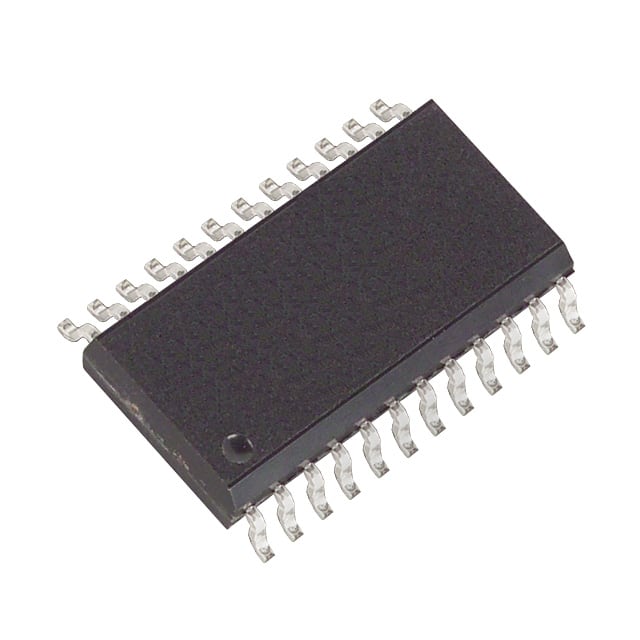Siehe Spezifikationen für Produktdetails.

MAX7219CWG
Product Overview
- Category: Integrated Circuit (IC)
- Use: LED Display Driver
- Characteristics:
- Serially Interfaced, 8-Digit LED Display Drivers
- Common-Cathode Configuration
- Constant-Current Segment Outputs
- Wide Supply Voltage Range: 4V to 5.5V
- Low Power Consumption
- Package: SOIC-24
- Essence: MAX7219CWG is a versatile LED display driver IC that simplifies the process of driving multiple LED segments in various applications.
- Packaging/Quantity: The MAX7219CWG is available in a surface-mount package and is typically sold in reels of 2500 units.
Specifications
- Maximum Supply Voltage: 5.5V
- Minimum Supply Voltage: 4V
- Maximum Operating Temperature: +125°C
- Minimum Operating Temperature: -40°C
- Number of Digits: 8
- Communication Interface: Serial
- Maximum Clock Frequency: 10 MHz
Pin Configuration
The MAX7219CWG has a total of 24 pins. The following table provides a detailed pin configuration:
| Pin Name | Description | |----------|-------------| | V+ | Positive Supply Voltage | | GND | Ground | | DIN | Serial Data Input | | CS | Chip Select | | CLK | Serial Clock Input | | LOAD | Load Signal Output | | SEG A-G | Segment Outputs | | DIG 0-7 | Digit Outputs |
Functional Features
- Simplified LED Display Control: The MAX7219CWG allows easy control of multiple LED segments through a simple serial interface.
- Constant-Current Drive: The IC provides constant-current outputs for each segment, ensuring consistent brightness across all LEDs.
- Daisy-Chaining Capability: Multiple MAX7219CWG ICs can be daisy-chained to drive larger LED displays.
- Power-Saving Mode: The IC includes a power-saving mode that reduces current consumption when the display is not actively updated.
Advantages and Disadvantages
Advantages: - Simplifies LED display driving process - Supports large displays through daisy-chaining - Consistent brightness across all segments - Low power consumption
Disadvantages: - Limited to common-cathode configuration - Requires external resistors for current control
Working Principles
The MAX7219CWG operates by receiving serial data input (DIN) and clock input (CLK) signals. It uses this data to control the state of each segment output, which in turn drives the connected LEDs. The chip select (CS) signal is used to enable or disable the IC. The LOAD signal is used to latch the data into the internal registers of the IC.
Detailed Application Field Plans
The MAX7219CWG is widely used in various applications, including: - Scoreboards and digital clocks - Advertising displays - Industrial equipment panels - Gaming machines - Instrumentation displays
Alternative Models
- MAX7221CWG: Similar to MAX7219CWG but with additional features such as a 4-wire serial interface and an on-chip BCD code-B decoder.
- HT16K33: LED driver IC with similar functionality, but supports both common-anode and common-cathode configurations.
In conclusion, the MAX7219CWG is a versatile LED display driver IC that simplifies the process of driving multiple LED segments. Its constant-current outputs, daisy-chaining capability, and low power consumption make it suitable for a wide range of applications. However, it is limited to common-cathode configuration and requires external resistors for current control.
Listen Sie 10 häufige Fragen und Antworten im Zusammenhang mit der Anwendung von MAX7219CWG in technischen Lösungen auf
Sure! Here are 10 common questions and answers related to the application of MAX7219CWG in technical solutions:
Q: What is MAX7219CWG? A: MAX7219CWG is a serially interfaced LED driver IC that can control up to 64 individual LEDs or 8-digit 7-segment displays.
Q: How does MAX7219CWG communicate with microcontrollers? A: MAX7219CWG uses a simple SPI (Serial Peripheral Interface) protocol to communicate with microcontrollers.
Q: Can I use MAX7219CWG to drive multiple 7-segment displays? A: Yes, you can daisy-chain multiple MAX7219CWG ICs to drive multiple 7-segment displays or LED matrices.
Q: What is the maximum number of LEDs that MAX7219CWG can control? A: MAX7219CWG can control up to 64 individual LEDs or 8-digit 7-segment displays.
Q: How do I connect LEDs or 7-segment displays to MAX7219CWG? A: You need to connect the anodes of the LEDs or 7-segment displays to the MAX7219CWG's output pins and the cathodes to ground.
Q: Can I adjust the brightness of the LEDs using MAX7219CWG? A: Yes, MAX7219CWG provides adjustable brightness control for the connected LEDs or 7-segment displays.
Q: Is it possible to cascade multiple MAX7219CWG ICs to control more than 8 digits? A: Yes, by cascading multiple MAX7219CWG ICs, you can control more than 8 digits or display larger LED matrices.
Q: Can I use MAX7219CWG with different microcontrollers or development boards? A: Yes, MAX7219CWG is compatible with various microcontrollers and development boards that support SPI communication.
Q: What is the maximum clock frequency supported by MAX7219CWG? A: MAX7219CWG supports clock frequencies up to 10 MHz.
Q: Are there any libraries or code examples available for using MAX7219CWG? A: Yes, there are several libraries and code examples available for popular microcontroller platforms like Arduino, Raspberry Pi, etc., which make it easier to work with MAX7219CWG.
Please note that these answers are general and may vary depending on specific implementations and requirements.

